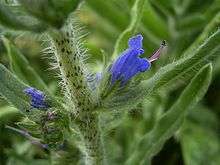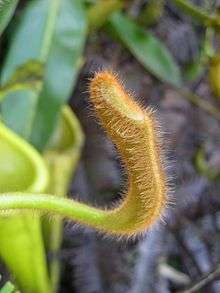Indumentum

Indumentum of Echium vulgare

Caducous hairs on a developing pitcher of Nepenthes chaniana
In biology, an indumentum (Latin, literally: "garment") is a covering of trichomes (fine "hairs") on a plant[1] or of bristles (rarely scales) of an insect.
In plants, indumentum types include:
- pubescent
- hirsute
- pilose
- villous
- tomentose
- stellate
- scabrous
- scurfy
The indumentum on plants can have a wide variety of functions, including as anchorage in climbing plants (e.g., Galium aparine), in transpiration control, in water absorption (Tillandsia), the reflection of solar radiation, increasing water-repellency (e.g., in the aquatic fern Salvinia), in protection against insect predation, and in the trapping of insects (Drosera, Nepenthes, Stylosanthes).
The use of an indumentum on insects can also be pollen-related, as on bees, sensory like whiskers, or for varied other uses including adhesion and poison.
.jpg)
Rust-colored indumentum on the underside of a bog Labrador tea (Rhododendron groenlandicum) leaf
See also
References
- ↑ Davis, Peter Hadland and Heywood, Vernon Hilton (1963) Principles of angiosperm taxonomy Van Nostrandpage, Princeton, New Jersey, page 154, OCLC 552236
External links
This article is issued from
Wikipedia.
The text is licensed under Creative Commons - Attribution - Sharealike.
Additional terms may apply for the media files.